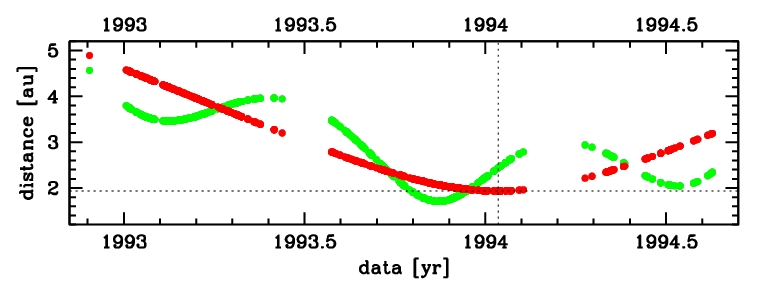| Solar System Dynamics & Planetology Group |
 |
C/1993 A1 Mueller |  |
| Solar System Dynamics & Planetology Group |
 |
C/1993 A1 Mueller |  |

| number of observations | 746 |
| number of residuals | 1483 |
| data interval | 1992 Nov. 26 — 1994 Aug. 17 |
| rms [arcsec] | 0.87 |
| orbit quality class | 1a |
| Epoch (TT) | 19921025.0 | = JD 2448920.5 |
| time of perihelion passage (TT) | 19940112.948616 | ± 0.000218 |
| perihelion distance | 1.93767483 | ± 0.00000382 |
| eccentricity | 1.00162360 | ± 0.00000420 |
| argument of perihelion [deg] | 130.666753 | ± 0.000137 |
| longitude of the ascending node [deg] | 144.719771 | ± 0.000026 |
| inclination [deg] | 124.878592 | ± 0.000020 |
| inverse semimajor axis [10-6 au-1] | -837.91 | ± 2.17 |
| Nongravitational parameters [10-8 au/day2] | A1 = 14.458 ± 0.215 | A2 = 0.135 ± 0.279 | A3 = -0.0890 ± 0.0627 |
| time shift of g(r) relative to perihelion [day] | -34.2 ± 3.2 |
| Epoch (TT) | 16930704 | |
| time of perihelion passage (TT) | 19940113.880951 | ± 0.000224 |
| perihelion distance | 1.94259216 | ± 0.00000386 |
| eccentricity | 0.99987986 | ± 0.00000428 |
| argument of perihelion [deg] | 130.672574 | ± 0.000137 |
| longitude of the ascending node [deg] | 144.723714 | ± 0.000027 |
| inclination [deg] | 124.970430 | ± 0.000020 |
| inverse semimajor axis [10-6 au-1] | 61.84 | ± 2.20 |
| Epoch (TT) | 22890411 | |
| time of perihelion passage (TT) | 19940113.944023 | ± 0.000433 |
| perihelion distance | 1.93446946 | ± 0.00000563 |
| eccentricity | 1.00080747 | ± 0.00000670 |
| argument of perihelion [deg] | 130.706997 | ± 0.000281 |
| longitude of the ascending node [deg] | 144.875683 | ± 0.000033 |
| inclination [deg] | 124.890818 | ± 0.000034 |
| inverse semimajor axis [10-6 au-1] | -417.41 | ± 3.46 |